As we reported earlier this week, Daniel Ahrendt has a rough recovery ahead of him after crashing on Jackson Street in May and getting run over by a Metro bus.
Both he and a Metro bus were headed westbound on Jackson. The bus was stopped in the curb lane, so Ahrendt moved into the left lane to pass when he fell. The bus then moved forward and ran over him with the back wheels.
Though Seattle Police said the cause of the crash is still under investigation, Ahrendt’s lawyer said his wheel got caught in the streetcar tracks. Though not one passenger has yet taken a ride on the First Hill Streetcar, many people have already crashed on Jackson Street since the tracks were installed in early 2014.
While new street designs do take some time for people to adjust and get used to them, it’s been well over a year and people are still getting hurt. So we know that the Jackson Street design is not safe as is, and we definitely know the intersection at Jackson/Rainier/Boren/14th is confusing. So let’s start thinking about how the city can make this intersection and the whole Jackson corridor safer.
Here’s a look at the confusing sharrow guides in that intersection (I also put together this short video for the first-person perspective):
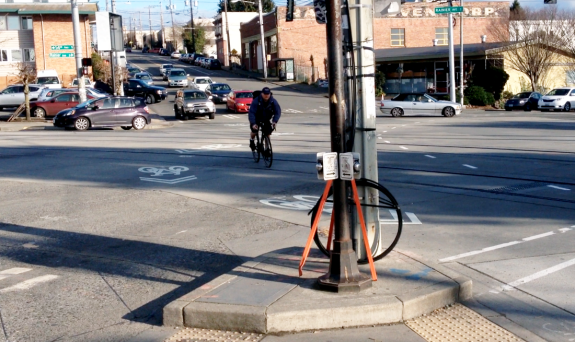 I’m gonna play a hardcore game of Armchair Traffic Engineer here. If you want to play along, here’s a link to the First Hill Streetcar design documents.
I’m gonna play a hardcore game of Armchair Traffic Engineer here. If you want to play along, here’s a link to the First Hill Streetcar design documents.
Due to the way the tracks turn onto 14th Ave S and the odd shape of the intersection, protected bike lanes may be the only complete solution to adequately address the challenges for biking. There are also opportunities to significantly reduce the crossing distances for people walking in the long crosswalks, especially helpful for people who move slowly due to health, age or ability issues.
I threw together the quick and rough GIF below showing how a “protected intersection” could possibly work. (Note: North points right in this map, which is from the final design documents for the First Hill Streetcar project)
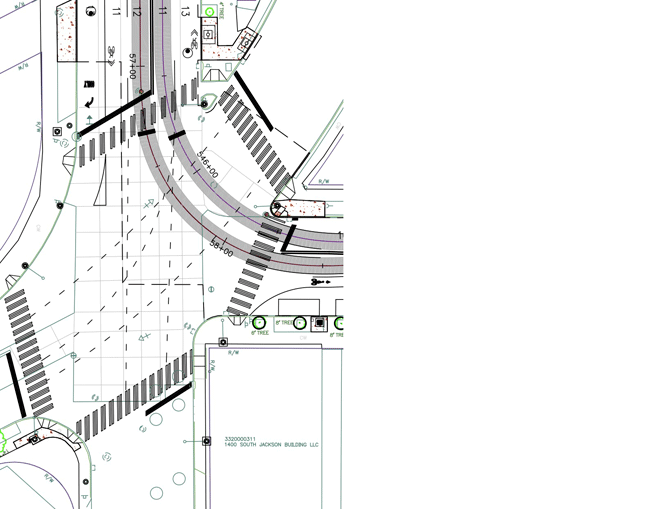 Each leg would have bike signals, and car turning movements would need to be designed or limited to avoid conflicts.
Each leg would have bike signals, and car turning movements would need to be designed or limited to avoid conflicts.
The westbound bike lane would lead people on bikes across both sets of tracks in one safe movement, effectively making the crossing in two legs: One to cross 14th and one to cross Boren. While people would typically make the whole crossing in one signal cycle, it’s possible someone who starts late in the cycle would be stopped between 14th and Boren, so there would need to be a waiting space there.
The eastbound bike lane would be a little more straight forward since there is no conflict with the tracks. The wide turn from eastbound Jackson to Rainier creates an opportunity for a far-advanced stop line for bikes, and the barrier protecting the bike lane could also calm turning traffic. Today, people can really whip around that corner without slowing down, creating a dangerous situation, especially for people walking.
Connecting to the northbound 14th Ave S bike lane is similar. Today, it’s a bit confusing if you’re trying to turn into this lane from eastbound Jackson because the left lane — which can either turn left or go straight — has streetcar tracks.
This intersection would also work well with future bike lanes on Rainier Ave, which are noted in the Bike Master Plan.
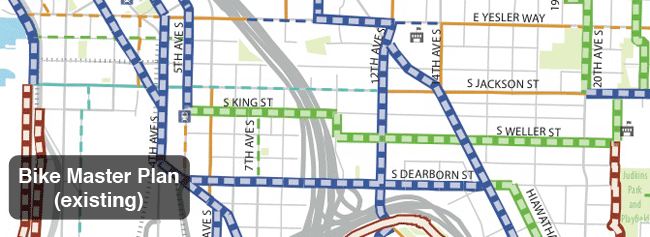 But this design also fits well into a redo of Jackson that includes bike lanes for its length. This is not in the Bike Master Plan, but it should be. No other street avoids steep climbs up First Hill, crosses I-5 and crosses the train tracks between the International District and Pioneer Square.
But this design also fits well into a redo of Jackson that includes bike lanes for its length. This is not in the Bike Master Plan, but it should be. No other street avoids steep climbs up First Hill, crosses I-5 and crosses the train tracks between the International District and Pioneer Square.
So what would Jackson look like with bike lanes? I threw together the images below using Streetmix. Note that the buffer space protecting the bike lanes could also be used for crosswalk islands, making the mid-block crossings to the streetcar platforms much shorter and more comfortable.
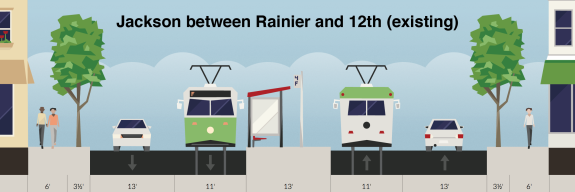


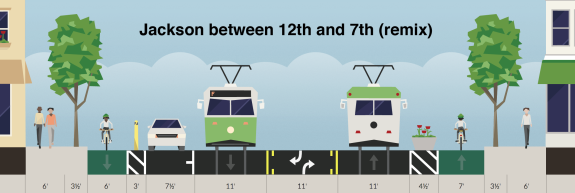
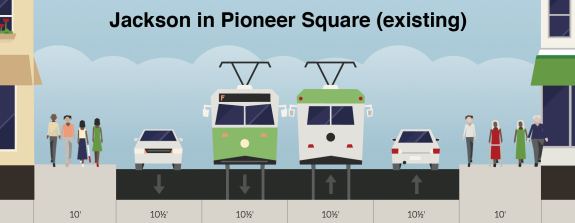
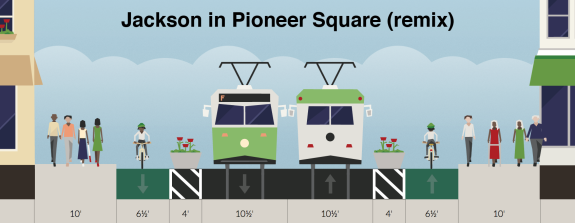 One option for buses would be for Metro to acquire buses with doors on both sides for all routes that travel on Jackson. That way they can serve the new and wonderful streetcar platforms rather than curbside bus stops. Otherwise (or additionally), new bus islands would be needed between the bike lane and the general purpose/streetcar lane.
One option for buses would be for Metro to acquire buses with doors on both sides for all routes that travel on Jackson. That way they can serve the new and wonderful streetcar platforms rather than curbside bus stops. Otherwise (or additionally), new bus islands would be needed between the bike lane and the general purpose/streetcar lane.
These designs also assume that the center lanes will not become transit-only, which is an option studied by the Center City Connector streetcar team. I suppose that’s something of an existential question for the city’s streetcar vision (the 1st Ave plans don’t include bike lanes, which seems like a recipe to repeat the problems we’re having on Jackson).
Vehicle volumes on Jackson are likely low enough to fit in these designs: 10,000 east of Rainier, 13,800 west of Rainier. To put that in perspective, the north section of Rainier Ave carries about 34,000 vehicles per day.
The primary concerns would be keeping buses on time and dealing with sports traffic. On the other hand, this project would make a whole lot easier to bike to the stadiums, which could help the traffic and parking problems in Pioneer Square and SODO during and following games.








Comments
40 responses to “The new Jackson Street isn’t safe, here’s a way to fix it”
I am a bike commuter who rides home on Jackson St. to avoid the climb up Yesler. Last week I did the exact same thing as Daniel Ahrendt. I was riding west on Jackson just after 12th I moved into the left hand lane to avoid 2 stopped buses in the bike lane. Next thing I knew my tire was in the street car track and I crashed. Lucky for me, the bus drivers saw the crash and waited for me to grab my bike & get to the sidewalk. One of them even opened the door and asked if I needed help. I walked away with a few scrapes, bruises & a new found hatred for streetcar tracks.
Before my crash I had wondered why there are not protected bike lanes on Jackson street. As you have pointed out ‘No other street avoids steep climbs up First Hill, crosses I-5 and crosses the train tracks between the International District and Pioneer Square.’ It also runs directly to King Street Station where daily bike commuters & pedestrians catch the sounder train & light rail. A new street design for bikers and pedestrians would greatly improve Jackson St.
Sorry for the novel, basically as a frequent rider of Jackson street who has now experienced its potential danger I feel strongly about this issue. If there is any way to get involved please let me know. Cheers!
That sounds terrifying. Please be sure to report your crash to the police, so that SDOT has a record of it! They’re much more likely to put money into fixing high crash locations.
This is a great idea and needs to be done. I headed down Westlake to SLU the other day and was reminded how dangerous those tracks are.
A green painted “safe route” path would really help in the interim too.
If we reserve a westbound bike lane on Jackson west of Rainier there’s no need to send bikes swinging around the perimeter of the intersection, possibly getting stuck in a two-stage crossing… just keep us on the current sharrow path over the tracks. The big problem with the sharrow path is that you have to follow it while riding in mixed traffic. Get rid of the mixed traffic and there’s no problem.
My other quibble is that Streetmix doesn’t tell the whole story on the block west of Rainier; the streetcar can drop passengers in the median but the (more numerous) buses can’t. They’ll either need raised islands in place of the buffer for a stretch (probably narrowing the bike lane a little), or to get to the curb (meaning no physical buffer for much of the block). Also there are a few driveways on this block, and I can’t imagine they’re going anywhere anytime soon. A bike lane of any kind could become more chaotic than the existing situation unless we really take a lot of care to get it right.
I know, we can set up special protected bus lanes that run the opposite direction of normal traffic, so the bus doors face the center platform.
Sure, it’s nonstandard and sets up new conflicts at every intersection, but that works so well for bikes….
Unfortunately the streetcar project was designed before the city started designing bike infrastructure for all ages and abilities. The protected bike lane on Broadway was included in the project because it allowed the city to avoid moving the utilities located under the street, and because a group of Capitol Hill residents suggested the protected bike lane. The concept of consistently and safely separating people on bikes from treacherous streetcar tracks and fast-moving traffic had not yet penetrated SDOT awareness, as can be seen both on Jackson and on Yesler, where bikes still share sections of lane with cars. This kind of design does nothing to move us into the category of truly bike-friendly city.
Sorry but I have to say that bikes and bike lanes were on Seattle streets before the CURRENT street car tracks were installed. this idea that street cars are a way to travel is not the way to go IMO. Trolleys, especially are more efficient than street cars and I am sure they are cheaper to maintain and cause none of these problems for cyclists! Why is the city instaling streetcars? This is probably too late but i wish we did not have any street car tracks and more trolleys.
Sometimes I feel the same way you do, but I think for the non-cycling contingent it does make a difference. Riding on a streetcar is much more comfortable than riding on a bus.
That said, it is obviously of paramount importance to make sure that cyclists have a safe route where ever tracks exist. And that doesn’t mean herding cyclists into narrow lanes where you have to ride 10mph.
I disagree Peri. There is widespread opposition to streetcars from people who love transit: http://seattletransitblog.com/2014/07/29/streetcars-a-momentary-lapse-of-reason/
This opposition has little to do with biking or bike safety, but everything to do with cost effective transit. The streetcar — our streetcar — has very few riders. It is far less popular than a typical bus, even though it was free to ride it until recently. So if it is smoother (and it isn’t always smoother) then it doesn’t seem to matter to riders.
Most of the transit riders, meanwhile, would rather have extra bus service. For the cost of all those miles of new rail, you could have lots of extra bus service — buses that can go up steep hills, avoid traffic, accidents or construction while carrying just as many people. Oh, did I mention — unlike some cities (like Toronto) our streetcars don’t carry any more capacity than our biggest buses.
The streetcars were a dumb idea. The sooner we get rid of them, the better.
The Streetcar Connector team, certain streetcar ROW would work, are certain a Couplet on 4th/5th isn’t even worth considering.
Jackson Streetcar should to straight to Alaskan Way. Keep Main as couplet. 1st Ave median stations plus curb stop operation is questionable. Better Trolleybus on 1st, straight to Queen Anne. At curb stops, ‘slight’ extensions at ped-crossings, outside lane wide for bike space. Conclusion: Streetcar on 1st ill advised and reconsider 4th/5th Couplet.
Losing the treescape south of Yesler, a streetcar could run on 1st Ave but then turn to the Waterfront on Yesler. I have defend the turn on Yesler. Removing the plane trees plus sidewalk rebuilds can improve traffic and transit overall. If streetcar on 1st served more than a minority of riders, then maybe, but 1st Ave is still ill-advised.
This may be an urban legend, but I always heard it was because the city could spend money on streetcars directly. Buses and trolleys are operated by Metro, and if the city gave them money it’d have to be split with the suburbs.
Not sure the Broadway bike lane has universal acclaim. Protected it is not.
We were lucky enough to just spend a week biking in the Netherlands (Den Haag / Delft), and we were riding over streetcar tracks everywhere, including (a bike lane going over right-turning tracks at a 45 degree or less angle). We’ve been wondering what is different.
It feels like it’s really just the general infrastructure, not necessarily anything specific to streetcar interaction. We never found ourselves going parallel to tracks because there are always bike lanes (or better) on any street busy enough to have tracks. And protection goes up at intersections rather than down. But even in cases like the photo (bike lane and no protection at an intersection), the overall environment is low stress so it was easy to notice these tracks whereas at home I’d be so worried about a right hook I’d never have seen them.
The infrastructure also made me feel more comfortable riding more slowly than I ever get to here.
Or the short version: great idea, Tom!
From what I recall of past streetcar discussions, and examples from the Netherlands:
– Dutch bikes tend to have wider tires that are less likely to get trapped in flange gaps
– Dutch cyclists have been riding over tram rails all their lives
– Dutch drivers are used to bikes riding over tram rails, and are much better trained than American drivers, so there’s less worry about getting run over while navigating an intersection
– Dutch cyclists still do have frequent falls on tram rails, but that’s accepted as a normal part of riding in the city, and usually it’s just a low-speed fall that isn’t followed by getting run over by a motorist
There’s no particular skill involved in riding over tram tracks in the Netherlands – people ride over them every which way with no problems. The tires there do seem to be generally wider; maybe the spaces in the tracks are also narrower? My intent here is not to blame the victims but I’d be very interested to know what kind of tires are ending up in the tracks. Is my cargo bike here with its beefy tires going to be fine here the same way the mamafiets was in Delft?
@Michelle: My take on it is something like…
– People in general are lousy at multitasking. It’s a lot easier to get over tracks safely, especially at funny angles, when you’re not trying to negotiate with traffic in your lane. Best practices for the two are often opposed, and it’s easy to react to traffic by steering straight into the rails when your attention is divided.
– It sounds like people go down on tracks in Europe, too. If your wheel goes into the tracks in heavy traffic that’s immediately a life-threatening situation. On a quiet street or bike path it’s less likely to become one. I’ve gone down on train tracks in the Chicago area a few times, but not in heavy traffic. I’ve also had a stick go between my spokes and gone over my handlebars in Champaign. There wasn’t much other traffic around, so it hurt, but wasn’t a big deal really. Heavy traffic multiplies the danger, and our streetcars run in heavy traffic.
– Unless we find someone to go out with a bunch of pads on and test different tire widths at various angles on different cities’ streetcar tracks we won’t know exactly about the relationship between tires, angle, and tracks.
Dutch tram rail flange gap is not dramatically narrower than what’s being used in Seattle — tire width is probably the more important variable.
You can see a decent selection of flange gap widths for European grooved rail at http://rails.arcelormittal.com/en/tram-rails.html
Flange gap, C2 on the dimensions table, has a fairly narrow range, 35 mm to 42.5 mm.
Seattle’s rails have a flange gap just wide enough for a 40 mm tire to drop to the bottom of the gap, but the tire needs to be nearly parallel to drop into the slot. Even at a shallow 33 degree crossing, a 40 mm tire rolls smoothly over the flange gap as long as the rail is flush with the pavement and the tire pressure is high enough that the tire doesn’t deform to follow the groove.
FYI, a decent, slightly-dated summary of streetcar issues and countermeasures from ALTA Planning & Design,
http://www.altaplanning.com/wp-content/uploads/Bicycle_Streetcar_Memo_ALTA.pdf
We should fix the problem. That cyclists is very luck he can have a full recovery, the injuries I heard he ended up with, most people with his injuries might not recover and might not ever be able to ride a bicycle again. This is one of the reasons so few people ride bicycles, safety. A lot of people are afraid of streets. I know this fix will not be cheap or easy, but its well worth it if our city is going to catch up to other cities as far as bicycle riding and make our city a healthier, less congested city. Seattle certainly beats cities like bellevue as far as bicycle infrastructure.
From my experience on Westlake, I think the most dangerous sections are where a cyclist turns a corner onto a street with tracks, or the tracks turn onto the street the cyclist is on.
If you already know the tracks are in the next lane and you don’t have an obstruction in your lane, it’s not hard to avoid them.
For example, I was going north from along lake union. When I got to Valley, I cycled across. Of course I know there are tracks on Westlake but I wasn’t thinking about which street I was on and I was watching traffic, anyway. All of a sudden, the tracks merged completely into my path (from Valley)! What to do? I’m in traffic – if I go, I hit the tracks; if I stop, I get hit from behind. (I had enough space to make a quick 60 degree jog and cross the tracks without hitting any vehicles. But it all took place in less than a second.)
This needs to be addressed on Jackson, especially considering the forementioned accidents. I don’t have a great solution for this. But perhaps signage would help.
The situation around Lake Union is sort of dumb…
– The streetcar’s frequent turns manage to both make it slower and more dangerous.
– For some weird reason they didn’t connect the west sidewalk of Fairview (the wide one that lots of people bike on, and is also a popular walking and running route) to a major path within the park. Anyone biking south (and most people on foot, who miss the turn to the squiggly trail that stays within the park) is shuttled across the streetcar tracks, only to have to cross them again if their ultimate destination is in the park or west of there. Since I live west of there, if I ride home from the U Bridge I have to cross both tracks at Fairview/Valley, then cross back over the northbound track at Terry and back over the southbound track at Westlake.
MOVE THE BUS STOP. sorry for yelling but unless I’m mistaken there is a simple solution to this. Move the bus stop slightly west. The bus stop can be adjacent to the street car stop in the center. If both bus and street car are stopped at the same time street both lanes will be blocked. Would be a slightly better transfer if anyone actually wants to use the street car
Yes — thank you, Sean R-M! There is no reason that the stop can’t be moved half-a-block west across from the center lane streetcar platform.
And, by the way, Yesler westbound is now closed at Broadway until 9/30(!) for construction so Jackson is the only option.
Adding to this streetcar issue.. The Seattle streetcars are not used enough to make a profit. Street cars are not profitable in Seattle! A better idea is the articulated, hybrid trolleys! They are cheaper and they can run on electric under the wire which is cheaper to install than rail and if the power goes out they can run on diesel! I just do not understand why SDOT keeps pushing the street car as a transportation solution! And I used operate the Waterfront Streetcar and the Monorail when I worked for Metro.
Articulated 60′ trolleybus cannot serve the hillclimb potential trolleybus technology offers. A 60′ articulated is both heavier and designed for freeway speeds for suburban commuting. Trolleybus are like streetcar: short routes specifically for hillclimbs and frequent service, ideally downtown between Capital/First Hills and 1st/Western Ave, Coleman Dock.
Give it up Seattle. Yer so screwd.
Sorry but you are using streetcarS as if we have a robust network of them….I, of course, agree with you about the South Lake Union streetcar being a disaster but I am not against streetcars as a whole. The truth is that it’s impossible to judge the usefulness of streetcars in Seattle until the First Hill line and the 1st ave connector are put in. I’d say the same argument could be made for the Broadway and 2nd Ave cycletrack. Let’s be honest, the daily amount of riders on those is pathetic at the moment, but it’s not fair to judge the usefulness of it until it’s connected to the rest of the bike network.
Connecting the Lake Union and Capital Hill streetcar lines would improve both, but a couplet connector on 4th/5th Aves would operate better/safer than left lane/median stations on 1st Ave competing with curbside bus service. Neither route serves the basic east/west travel demand between Broadway and 1st Ave. An effective, frequent service transit grid downtown is most readily achieved with trolleybus.
Can you suggest *any* transportation system in the U.S. that operates at a profit?
Private cars? Not a chance.
Private bus lines? Only if you ignore the huge general fund subsidy for the roads and highways they use.
Amtrak? Sounder? Monorail? Subways?
I agree veganbike. Like any mode, streetcars make sense for particular situations. But Seattle has none of those. Here are when streetcars make sense:
1) On a very flat city (like Toronto).
2) There already is a major streetcar infrastructure (like Toronto).
3) The streetcars themselves can carry more people than a big bus (this is the case in Toronto, but not in Seattle).
4) The street has enormous demand for transit along a corridor, and needs the extra capacity of a streetcar. This occurs in very dense cites (like New York or Toronto, but rarely, if ever in a city like Seattle).
5) They can revitalize a neighborhood. This part is debatable (studies are inconclusive). It is reasonable for a city like Tacoma or Detroit to try and spur development with a streetcar. Seattle, last time I checked, really doesn’t need any help.
6) They can reverse direction without turning around. This advantage rarely comes into play (maybe on a long, narrow, heavily populated dead end street).
Streetcars just aren’t appropriate for Seattle. We are in the midst of spending a substantial amount of money on something that works worse than a bus. It is less flexible (it can’t be rerouted easily). One accident or stalled car and it can’t move. Construction (forcing drivers into the other lane) means that it doesn’t run. They can’t be routed up a steep hill (and we are one of the hilliest cities in the U. S.) . Meanwhile, the streetcars we bought don’t carry more people than the biggest buses we have (we have some big buses and those are small streetcars). To spend tens of millions of dollars on the streetcars instead of just bus improvements was stupid. Even hard core transit advocates don’t like them: http://seattletransitblog.com/2014/07/29/streetcars-a-momentary-lapse-of-reason/
One of the big reasons we did it is because the federal government paid for much of it (Yay! Free money!). Still a major waste of money (since we did need to chip in).
But I agree with the other comments that profit has nothing to do with it. Transit systems generally lose money (the monorail is the one exception in the area). But they serve the greater good. Besides, until recently the streetcar didn’t charge, as long as you owned an ORCA card. It is hard to make money if the rides are free. Even with the free rides, though, they carry way fewer people than a typical bus.
Only sparse interspersed moments alight on two wheel Seattlers who
find themselves tarried otherwise between this that and there then when why
and why? And why wouldn’t a 2-wheeler whist past west east south at speed,
speed oblivious to others at other speeds? Speeding. Always speeding. Speed walking!
Another potentially dangerous situation exists at the intersection of Jackson and 2nd Ave Extension. If you’re biking south along 2nd Ave and want to turn left onto eastbound Jackson, you want to make sure that you don’t try to turn into the left lane, as you’ll end up turning into a lane with streetcar tracks in it, and you’ll be crossing them at a bad angle. You want to end up in the right/curb lane. However, there are often buses backed up in the right lane, so it’s tempting to get into the left lane. I’m not sure what the solution is (signage for bicyclists? painted sharrow symbols on 2nd directing bikes to the right lane?), but that might be something to also address.
I’m chiming in here as yet another cyclist that was seriously injured at this intersection. The difference between me and Daniel though is that I slipped crossing the tracks (my wheel did not become entrapped) due to the inability to cross at a 90-degree angle. It was raining that day and I ride a road bike with skinny tires. My accident was 10 months ago and resulted in a fractured pelvis and a torn labrum and am still facing surgery. My first day riding my bike to work after my accident was the day that Daniel was injured and I biked by right after he had been taken to the hospital.
All that being said, there are multiple reasons why the tracks at that intersection are dangerous. I like Tom’s idea of the bike lanes to cross the tracks at a better angle and to alleviate the swerving out of the lane you currently have to do if you follow the sharrows.
[…] St are hazardous to people on bikes, and there is no parallel facility. Seattle Bike Blog explores design changes to fix […]
I’m usually not a fan of video, but that video was amazing. In thirty seconds it explained the situation better than three paragraphs and a couple charts. Well done.
As someone who drives more than he bikes, that is absolutely insane. If I’m behind that bike rider, I assume that the rider never signaled and is headed towards Boren. Or maybe he or she is just headed to the right sidewalk at the corner. Either way, my first thought it “OK, I don’t have to worry about the bike anymore”. I’m a slow driver (on city streets) so I wouldn’t assume much, but I could easily speed up as I see the bike headed off to my right. Then when the bike cuts back (as the rider should do) I slam on the brakes and maybe hit the horn (followed by yelling “What the hell are you doing?”). Later, of course, I realize what is going on (tracks) and it all makes sense. My anger should be addressed at city planners, not the biker (“What the hell are you doing, SDOT?”).
Keep in mind, this is not even the situation that caused the accident mentioned. In my little scenario, there is no bus stopped there. That situation (changing lanes) is a lot more common. The situation on the video is confusing, unusual and potentially deadly. The other situation is understandable, common and potentially deadly.
If there is a bright light at the end of the tunnel, it is that the streetcars will soon clog up the streets. With the streets clogged, vehicles (cars, buses, streetcars and bikes) all move slower. So that part of the city won’t move any faster, but at least it will be safer. Maybe.
[…] Fixing Jackson: Seattle Bike Blog says that Jackson Street is just unsafe for bikes, but there’s a fix for it if the City pursues it. […]
Fantastic write up and a great idea.
Jackson is also the gentlest slope going east from Rainier Ave. My rough calculation pegs the 0.3 mile hill at 89 ft elevation gain (5.6% grade) vs. 115 ft (7.3%) on Weller, and Weller’s hill comes right after a 40 ft decline from 12th, creating extra work. Taking that 40 ft climb in the other direction is about a 9.6% grade, which is probably fine for most seasoned bike riders but more casual riders would probably prefer Jackson.
Back to eastbound, it’s wide, underutilized and lined with free parking instead of providing safe right of way to vulnerable users on a stretch where people tend to drive fast, intersections are not well defined and the area is poorly lit at night. I have personally witnessed two hit and runs at 20th, just a block from the middle school. Anything that calms traffic and encourages more active use by people would be a good thing. I expect protected bike lanes would bring more business to local shops and restaurants too.
It is a bit tangential to the main issue but it’s still important. So many projects miss the big picture. The fact that no one noticed a problem with putting a Missing Link squiggle in the middle of an auto gauntlet is a perfect example.
I bicycle my children through these parts daily, silently cursing the rails, and am so grateful that you have put forward such a thoughtful set of ideas and documentation. Please let me know if I can help move them into reality. My photogenic children and I are available for in person visits with SDOT, WSDOT, whomever needs convincing.
Has anyone considered using King St. for going uphill (and maybe downhill, too)? True, it doesn’t go all the way to the water.
For uphill, it’s much better than Jackson. No tracks, less traffic. For downhill, it could be improved with stop signs for cross traffic (it may already have them, I don’t remember). If I recall, the sightlines are pretty good.
[…] This leads into the answer for the third and final question. To start with, it is absolutely possible to redesign Jackson Avenue to have an exclusive transit lane for both streetcars and buses, but the streetcar tracks and stations would need to be demolished and relocated to the outsides of the roadway. This would leave two general purpose lanes and a center turn lane for automobiles, which is plenty of capacity for the traffic volume that Jackson Avenue carries; SDOT has done numerous other street rechannelizations that have shown this to be the case. Jackson Avenue also has discontinuous bicycle facilities that have already led to at least one serious injury. […]